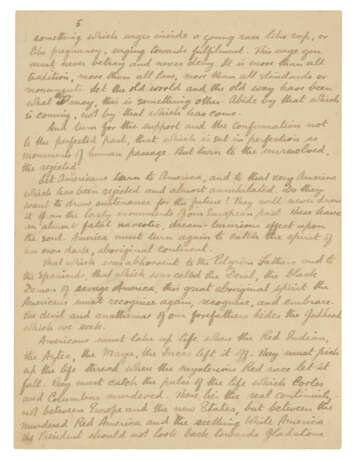ID 1249819
Lot 73 | D.H. Lawrence (1885-1930)
Valeur estimée
£ 18 000 – 25 000
Autograph manuscripts and corrected typescripts of Studies in Classic American Literature, [1917-1922]
c.519 page in total, various sizes, chiefly 210 x 175mm and 280 x 220mm. Laid in 10 yellow silk-covered folding cases, morocco labels, within two half morocco folding boxes gilt by James Brockman, Oxford. Provenance: Sotheby's, 19 July 1990, lot 176.
The genesis of Studies of Classic American Literature (1923), D.H. Lawrence’s pioneering piece of literary criticism reviewing the great eighteenth- and nineteenth-century American writers: over 500 autograph manuscript and typescript pages.
Comprising:
Box I
i) Autograph manuscripts, with emendations, of five of the essays in the books: i) ‘Dana’, 22 pages, paginated 2-7, 9-23; ii) ‘Herman Melville (1)’ [Typee and Omoo], 14 pages; iii) ‘Herman Melville (2)’ [Moby Dick], 26 pages; iv) ‘Nathaniel Hawthorne (II)’ [Blithedale Romance], 9 pages of manuscript (paginated 1-9) and 5 pages corrected galley proof (paginated 10-13); v) ‘Whitman’, 20 pages
ii) Autograph manuscript signed, ‘Foreword to Studies in Classic American Literature’, dated Florence 1920 at the end, with emendations and cancellations and deletions, 6 pages; [and:] Corrected typescript of the same, incorporating the changes made in the manuscript, with a few autograph corrections and one annotation, 6 pages
iii) Carbon typescript of ‘Whitman’, 8 pages
Box II
iv) Autograph manuscript and corrected typescript of the final version of Studies in Classic American Literature, published in 1923. 164 pages, paginated in autograph, 86 pages entirely in autograph, much of the remaining typescript bearing extensive autograph emendations: i) ‘Foreword’ (pages 1-2); ii) ‘The Spirit of Place’ (3-10); iii) ‘Benjamin Franklin’ (11-23); iv) ‘Henry St. John de Crevecoeur’ (24-36); v) ‘Fenimore Cooper's White Novels’ (37-47, of which 42-47 are autograph); iv) ‘Fenimore Cooper's Leatherstocking Novels’ (48-60, entirely autograph); iv) ‘Edgar Allan Poe’ (61-79, 72a, of which 61-69 are autograph, no pages 76-78 but text complete); viii) ‘Nathaniel Hawthorne and The Scarlet Letter’ (80-93, entirely autograph); ix) ‘Nathaniel Hawthorne's Blithedale Romance’ (94-102, entirely autograph); x) ‘Dana's Two Years Before the Mast’ (103-124, of which 103-104 and 108-111 entirely autograph); xi) ‘Herman Melville's Typee and Omoo’ (125-137, entirely autograph); xii) ‘Herman Melville's Moby Dick’ (138-156, of which 138-139, 142-143 and 155-166 are entirely autograph); xiii) ‘Whitman’ (157-166, entirely autograph)
v) Complete carbon typescript of Studies in Classic American Literature, including ‘The Two Principles’, which did not appear in the 1923 volume, with a few minor corrections. 239 pages: i) ‘Foreword’ (paginated 1-2), a different version from the two above; ii) ‘The Spirit of Place’ (3-19, 5a, 14a); iii) ‘Benjamin Franklin’ (20-35); iv) ‘Henry St. John de Crevecoeur’ (33 [sic]-52, lacks page 49 with gap in text); v) ‘Fenimore Cooper's Anglo-American Novels’ (53-69); vi) ‘Fenimore Cooper's Leatherstocking Novels’ (70-90); vii) ‘Edgar Allan Poe’ (1-18); viii) ‘Nathaniel Hawthorne’ (1-17); ix) ‘Nathaniel Hawthorne's Blithedale Romance’ (1-12); x) ‘The Two Principles’ (1-17); xi) ‘Dana's Two Years Before the Mast’ (1-24); xii) ‘Herman Melville's Typee and Omoo’ (1-12, [2]a); xiii) ‘Herman Melville's Moby Dick’ (1-22); xiv) ‘Whitman’ (1-17, 2a, 8a-e, no page 9)
In January 1917, Lawrence wrote to his agent proposing a trip to America, where he intended to write a series of essays on American literature. His request for a passport was denied, for a second time, so he began work in Cornwall instead. By 1918 he was back in the Midlands, at Middleton by Wirksworth, writing in a cottage paid for by his sister, Ada: Lawrence and Frieda had been expelled from Cornwall as the military authorities objected to a suspect writer and an enemy alien living near shipping lanes where German submarines were inflicting heavy losses on Allied ships, which only confirmed a sense of alienation from his country. That same year, the English Review published the first versions of what became Studies of Classic American Literature [only ‘Whitman’, of the five essays listed above in i, was published in periodical form prior to the 1923 book]; the ‘Foreword to Studies in Classic American Literature’ [see ii above] is not the version eventually published in the book in 1923, rather it was published a few years earlier, in the New Republic, on 15 December 1920, as ‘America, Listen to Your Own’. For several years Lawrence continued to make drastic revisions of his book; after the Lawrences emigrated to America in 1922, they spent their first winter at the Del Monte ranch on Lobo Mountain, where Lawrence managed a final reworking of the much revised Studies, shortening and Americanizing the studies in accordance with his new experience.
A ‘second’ version of the book[here in a carbon typescript, v above] was completed in 1920 and published in 1964 as The Symbolic Meaning. This version differs radically both from the early autograph [i above] and the final version [iv, above] published in 1923.
| Artiste: | David Herbert Lawrence (1885 - 1930) |
|---|---|
| Lieu d'origine: | Angleterre, Europe du Nord, Europe, Royaume-Uni |
| Catégorie maison de vente aux enchères: | Lettres, documents et manuscrits, Livres et manuscrits |
| Artiste: | David Herbert Lawrence (1885 - 1930) |
|---|---|
| Lieu d'origine: | Angleterre, Europe du Nord, Europe, Royaume-Uni |
| Catégorie maison de vente aux enchères: | Lettres, documents et manuscrits, Livres et manuscrits |
| Adresse de l'enchère |
CHRISTIE'S 8 King Street, St. James's SW1Y 6QT London Royaume-Uni | |
|---|---|---|
| Aperçu |
| |
| Téléphone | +44 (0)20 7839 9060 | |
| Commission | see on Website | |
| Conditions d'utilisation | Conditions d'utilisation |













![[D.H. Lawrence (1885-1930)] – Nathaniel Hawthorne (1804-1864)](/assets/image/picture_3643920/622c4/dhgyeqmhvqzrf2jksesrm4tm8jmwv8oowk-rcfxvshw895ypwrimpmlzhn5ivgas1701505309jpg__fix_162_205.jpeg)

![[D.H. Lawrence (1885-1930)] – Robert Browning (1812-1889)](/assets/image/picture_3643917/29247/nsx1mcglqntcbud3m0hynfmrqoipi7iioqejtkyukv8sx8jslibvanbgvmfygqze1701505298jpg__fix_162_205.jpeg)

